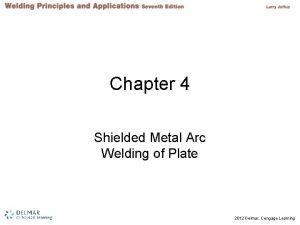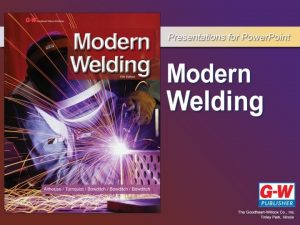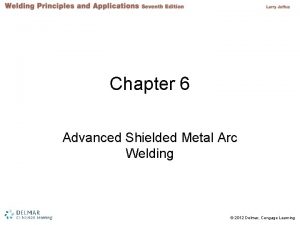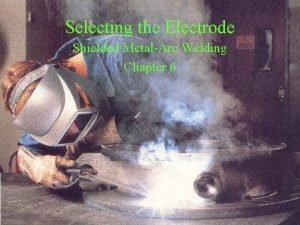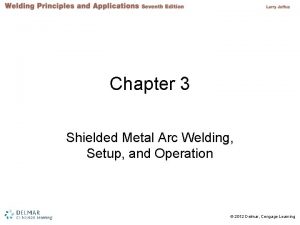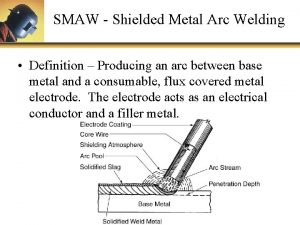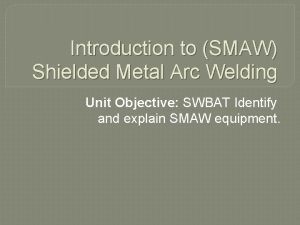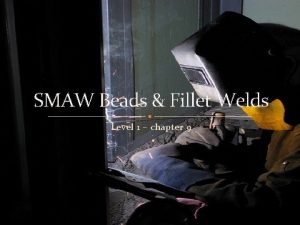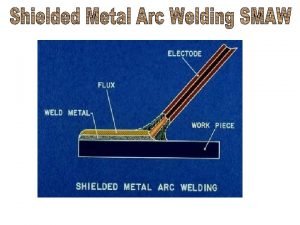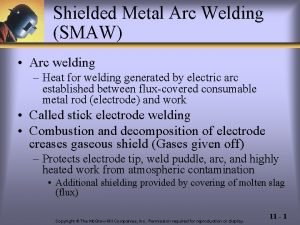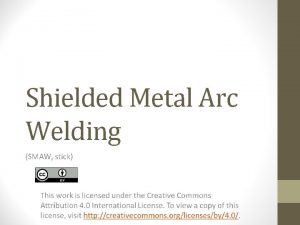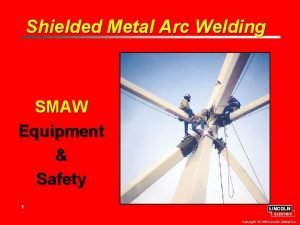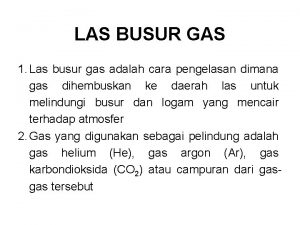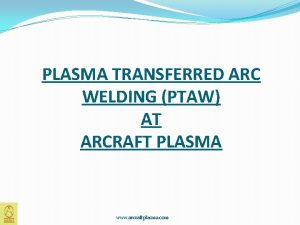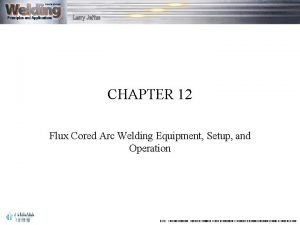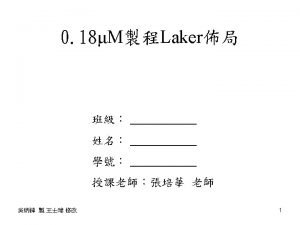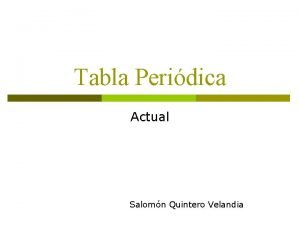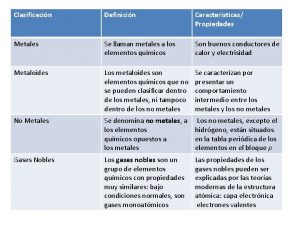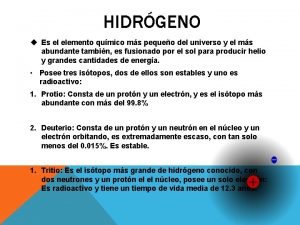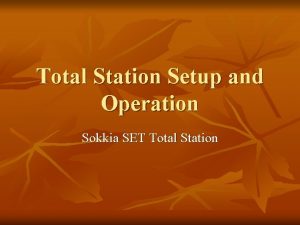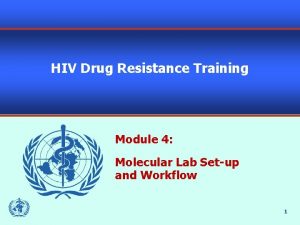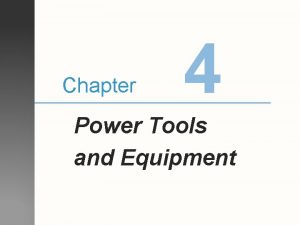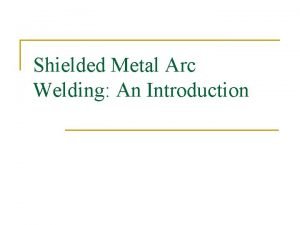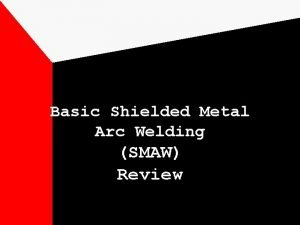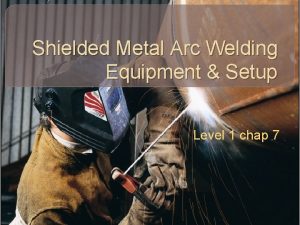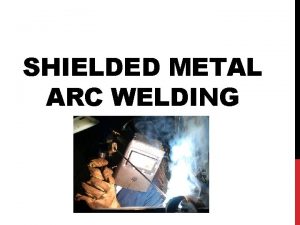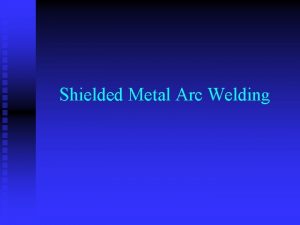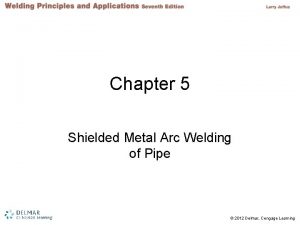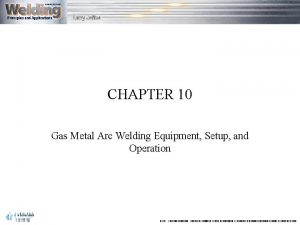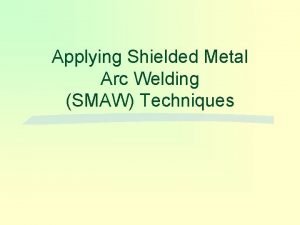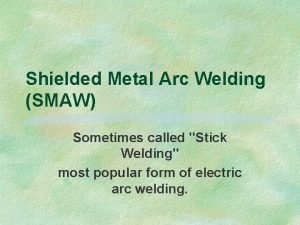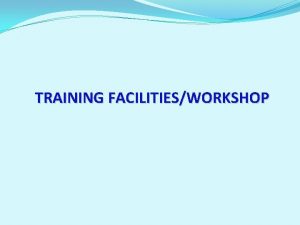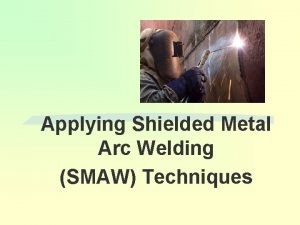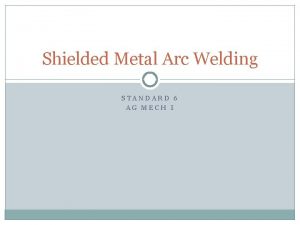Chapter 8 Shielded Metal Arc Equipment Setup and





































- Slides: 37

Chapter 8 Shielded Metal Arc Equipment, Setup, and Operation

Objectives Look at: ◦ ◦ ◦ ◦ SMAW Process Basic Electricity (and I mean basic) Welding Polarity Open Circuit Voltage (OCV) Arc Blow Duty Cycle Types of Welding Equipment Chapter #8 – SMAW Equipment Setup and Operation

SMAW S = Shielded M = Metal A = Arc W = Welding Chapter #8 – SMAW Equipment Setup and Operation

FIGURE 8 -1 Shielded metal arc welding. American Welding Society Chapter #8 – SMAW Equipment Setup and Operation

SMAW Basic Operating Factors 1. ARC LENGTH 2. ELECTRODE ANGLE 3. SPEED OF TRAVEL 4. AMPERAGE Chapter #8 – SMAW Equipment Setup and Operation

What is arc length? THE DISTANCE BETWEEN THE TIP OF THE ELECTRODE AND THE BASE METAL BEING WELDED Chapter #8 – SMAW Equipment Setup and Operation

When running a straight bead, at what angle should the electrode be held? a) b) THE ANGLE FROM THE VERTICAL PLANE IN THE DIRECTION OF WELDING: 20 – 30 DEGREES THE ANGLE AS SEEN FROM THE END VIEW : 90 DEGREES Chapter #8 – SMAW Equipment Setup and Operation

Welding Current Welding current ◦ Electricity that jumps across the arc gap Between electrode end and metal being welded Electric current ◦ Flow of electrons ◦ Resistance to electron flow produces heat Greater resistance: greater heat Air has high resistance Chapter #8 – SMAW Equipment Setup and Operation

Basic Electricity: 1. Voltage 2. Amperage 3. Watts 4. Resistance Chapter #8 – SMAW Equipment Setup and Operation

Electrical Measurement Units to describe electrical current ◦ Voltage or volts (V): measurement of electrical pressure ◦ Amperage or amps (A): measurement of the total number of electrons flowing ◦ Wattage or watts (W): measurement of electrical energy or power in the arc ◦ Resistance (R): opposes the flow of electrons Chapter #8 – SMAW Equipment Setup and Operation

SMAW Arc Temperature and Heat Welding arc temperature ◦ Dependent on voltage, arc length, and atmosphere Heat produced by the arc FIGURE 8 -5 Energy is lost from the weld in the forms of radiation and convection. © Cengage Learning 2012 ◦ Determined by amperage Chapter #8 – SMAW Equipment Setup and Operation

Types of Currents (Polarity) Types of currents used for welding ◦ Direct-current electrode negative (DCEN) Electrode is negative and work is positive ◦ Direct-current electrode positive (DCEP) Electrode is positive and work is negative ◦ Alternating current (AC) Electrons change direction every 1/120 of a second Electrode and work alternate from anode to cathode Chapter #8 – SMAW Equipment Setup and Operation

Sketch of a DCEP arc welding circuit for SMAW DCEP = DC Electrode Positive DCRP = DC Reverse Polarity DC + Chapter #8 – SMAW Equipment Setup and Operation

Sketch of a DCEN arc welding circuit for SMAW DCEN = DC Electrode Negative DCSP = DC Straight Polarity DC - Electrode - Work + Chapter #8 – SMAW Equipment Setup and Operation

Sketch of a AC arc welding circuit for SMAW FIGURE 8 -9 In an alternating current, electrons flow back and forth. © Cengage Learning 2012 Chapter #8 – SMAW Equipment Setup and Operation

What is the determining factor in deciding the polarity to be used for SMAW welding? The coating on the SMAW electrode Larger selection of electrodes for DC current Chapter #8 – SMAW Equipment Setup and Operation

Welding Power (CC vs CV) SMAW process ◦ Requires a constant current arc voltage characteristic ◦ SMA welding machine Voltage output decreases as current increases FIGURE 8 -10 Constant voltage (CV) and constant current (CC). © Cengage Learning 2012 Chapter #8 – SMAW Equipment Setup and Operation

How can you most easily identify whether an arc welding power source is a CC or CV type by looking at the controls? CC – Amperage Adjustment only - See next slide for photo Chapter #8 – SMAW Equipment Setup and Operation

Chapter #8 – SMAW Equipment Setup and Operation

How can you most easily identify whether an arc welding power source is a CC or CV type by looking at the controls? CV – Voltage Adjustment - WFS (wire feed speed) Adjustment - see next slide for photo Chapter #8 – SMAW Equipment Setup and Operation

Voltage WFS Chapter #8 – SMAW Equipment Setup and Operation

SMAW Welding Machine Types 1. AC Machines 2. Portable Engine Driven Power Source (AC/DC) 3. AC/DC Rectifier 4. Multi-Process Inverter (AC/DC). Chapter #8 – SMAW Equipment Setup and Operation

1) AC MACHINES Chapter #8 – SMAW Equipment Setup and Operation

2) Portable Engine Driven Power Source (AC/DC) Chapter #8 – SMAW Equipment Setup and Operation

3) AC/DC Rectifier Chapter #8 – SMAW Equipment Setup and Operation

Name three types of arc welding machines. 1. AC/DC Rectifier Half Wave Rectification Full Wave Rectification Chapter #8 – SMAW Equipment Setup and Operation

4) Multi-Process Inverter (AC/DC) Chapter #8 – SMAW Equipment Setup and Operation

Open Circuit Voltage (OCV) Voltage at electrode before striking an arc Maximum Voltage – 80 V The higher the OCV the easier it is to strike an arc The higher the OCV the increase in chance of electric shock Newer technology drops OCV below FIGURE 8 -11 Electricity can have an initial surge much 30 V once arc is established like the surge of water when a garden hose nozzle is first opened. © Cengage Learning 2012 Chapter #8 – SMAW Equipment Setup and Operation

Arc Blow When welding with DC current the arc flares uncontrollably to the side of the electrode instead of straight down Caused by a constriction of magnetic flux lines Possible Solutions Switch to AC Move work lead clamp Short arc length and different electrode angle Change welding direction Lower current setting Chapter #8 – SMAW Equipment Setup and Operation

Duty Cycle Percentage of time a welding machine can be used continuously at a specified amperage ◦ Increases as amperage is reduced ◦ Decreases as amperage is raised FIGURE 8 -31 Duty cycle of a typical shielded metal arc welding machine. © Cengage Learning 2012 Chapter #8 – SMAW Equipment Setup and Operation

Electrode Holders Characteristics ◦ Should be of proper amperage rating and in good repair ◦ Used at maximum amperage rating or less FIGURE 8 -33 The amperage capacity of an electrode holder is often marked on its side. Thermadyne Industries, Inc. Chapter #8 – SMAW Equipment Setup and Operation

Work Clamps Characteristics ◦ Must be correct size for current used ◦ Must clamp tightly to material ◦ Must be in good repair FIGURE 8 -35 A work clamp may be attached to the workpiece. © Cengage Learning 2012 Chapter #8 – SMAW Equipment Setup and Operation

Loss Of Welding Power. Loose connections at the power source Loose connection at the work connector or electrode holder Splices in the cable Too small of cable for amperage being used Broken strands in cable not properly repaired Enlarge hole in cable lug to fit larger stud size Use of excessively long cables Chapter #8 – SMAW Equipment Setup and Operation

Briefly explain what is meant by a “stray welding current. ” When some or all of the welding current does not return to the power source through the work lead Usually results from poor cable connections or work piece connection (cable damage, loose fittings, painted surfaces, etc. ) Chapter #8 – SMAW Equipment Setup and Operation

Describe the welding technique used in padding and name three areas where padding may be used. PADDING TECHNIQUE: THE PLACING OF BEADS OR WEAVES SIDE BY SIDE SO THAT EACH NEW WELD OVERLAPS THE ONE PRECEDING IT Chapter #8 – SMAW Equipment Setup and Operation

Practicing Padding in The Shop Chapter #8 – SMAW Equipment Setup and Operation

PADDING IS USED: 1. SHAFTS 2. SHOVELS 3. GRADER BLADES Chapter #8 – SMAW Equipment Setup and Operation
 Why must the electrode holder be correctly sized?
Why must the electrode holder be correctly sized? Chapter 4 shielded metal arc welding
Chapter 4 shielded metal arc welding Arc welding objectives
Arc welding objectives Chapter 6 shielded metal arc welding
Chapter 6 shielded metal arc welding Welding position
Welding position In alternators the welding current is produced on the
In alternators the welding current is produced on the Application of shielded metal arc welding
Application of shielded metal arc welding Introduction of smaw
Introduction of smaw Smaw stands for
Smaw stands for Welding smaw
Welding smaw Smw process
Smw process Shielded metal arc welding definition
Shielded metal arc welding definition Smaw safety
Smaw safety Las busur gas
Las busur gas Minor segment of a circle
Minor segment of a circle Minor arc of a circle
Minor arc of a circle Arc promoteur vs arc investigateur
Arc promoteur vs arc investigateur Arc emu88 com arc info 37 100037 html
Arc emu88 com arc info 37 100037 html Periodic trends acidity
Periodic trends acidity Difference between metal oxides and non metal oxides
Difference between metal oxides and non metal oxides Metals are used
Metals are used Is sulfer a metal nonmetal or metalloid
Is sulfer a metal nonmetal or metalloid Dr terry blanch
Dr terry blanch Metalloids vs metals
Metalloids vs metals Examples of non metal
Examples of non metal Ptaw welding
Ptaw welding What is globular transfer
What is globular transfer Venn diagram matter
Venn diagram matter Hot nwell
Hot nwell Metals react with nonmetals to form ionic compounds by
Metals react with nonmetals to form ionic compounds by Metal no metal y metaloide tabla periodica
Metal no metal y metaloide tabla periodica Metales no metales y metaloides
Metales no metales y metaloides Hidrgeno
Hidrgeno Shielded storage store
Shielded storage store Sokkia total station resection method
Sokkia total station resection method Setup time and hold time in digital electronics
Setup time and hold time in digital electronics Drug resistance training
Drug resistance training Chapter 4 power tools and equipment answers
Chapter 4 power tools and equipment answers

